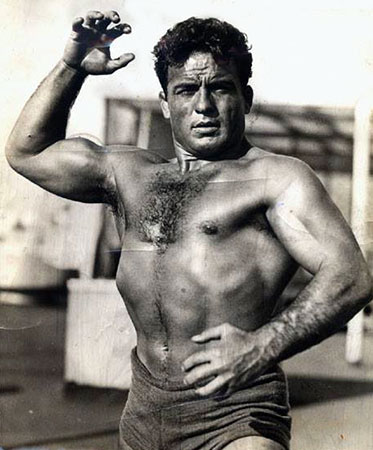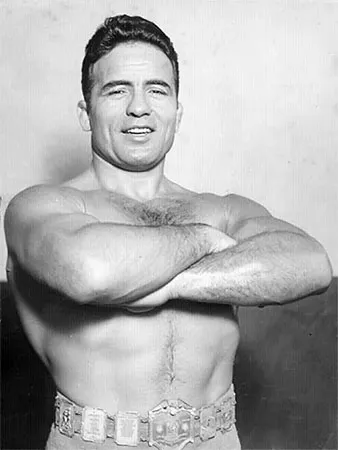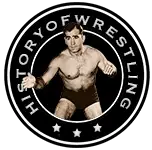by Stephen Von Slagle
 Jim Londos, “The Golden Greek,” was the premier wrestler in America during the lean years during and after the Great Depression, and he was one of the few performers that kept the fans coming out to the matches during this very trying economic time, despite the lack of available spending money. Indeed, factoring in inflation and the differences in currency, Jim Londos is still the all-time greatest box-office attraction in the long history of professional wrestling. More financially productive than Bruno Sammartino, Andre the Giant, Hulk Hogan, Steve Austin, Ric Flair, The Rock or any other top superstar one can think of, Londos remains, dollar-for-dollar, the single biggest revenue generator the sport of professional wrestling has ever known.
Jim Londos, “The Golden Greek,” was the premier wrestler in America during the lean years during and after the Great Depression, and he was one of the few performers that kept the fans coming out to the matches during this very trying economic time, despite the lack of available spending money. Indeed, factoring in inflation and the differences in currency, Jim Londos is still the all-time greatest box-office attraction in the long history of professional wrestling. More financially productive than Bruno Sammartino, Andre the Giant, Hulk Hogan, Steve Austin, Ric Flair, The Rock or any other top superstar one can think of, Londos remains, dollar-for-dollar, the single biggest revenue generator the sport of professional wrestling has ever known.
Jim Londos was born Christopher Theophelus during the late 1800’s (no exact date for his birth was recorded) in Argos, Greece. The youngest of thirteen children, Theophelus ran away from home at the age of 13, just after the turn of the century. Eventually, he made his way from Greece to America, where he worked the various sorts of jobs that were available to newly transplanted immigrants at this time in history. But, when he landed a job as a catcher in a carnival acrobatic act, the young, athletic Theophelus first came into contact with the world of professional wrestling.
 Theophelus, who learned his trade and paid his dues on the rough carnival circuit, was one of the last World champions to have competed during the “legitimate” era of the sport, when true contests were still a common, although far from predominant, occurrence in the sport. However, Jim Londos was a performer, not a shooter, and he was known more for his good looks and well-muscled physique than his wrestling ability. That said, he was a more than capable grappler and was generally considered by his peers as one of the best “workers” of his time. His ability inside the ring, good looks, and popularity with the fanbase enabled Londos to eventually establish himself as wrestling’s all-time top box-office draw and one of the most recognized wrestling names in the sport during his era. As the World Heavyweight champion, he helped set a standard for future champions, wrestlers born decades after he was gone, and truly left an imprint that has lasted throughout the history of the sport in the 20th century and beyond.
Theophelus, who learned his trade and paid his dues on the rough carnival circuit, was one of the last World champions to have competed during the “legitimate” era of the sport, when true contests were still a common, although far from predominant, occurrence in the sport. However, Jim Londos was a performer, not a shooter, and he was known more for his good looks and well-muscled physique than his wrestling ability. That said, he was a more than capable grappler and was generally considered by his peers as one of the best “workers” of his time. His ability inside the ring, good looks, and popularity with the fanbase enabled Londos to eventually establish himself as wrestling’s all-time top box-office draw and one of the most recognized wrestling names in the sport during his era. As the World Heavyweight champion, he helped set a standard for future champions, wrestlers born decades after he was gone, and truly left an imprint that has lasted throughout the history of the sport in the 20th century and beyond.
At 5`8″ and 200 pounds, Londos was often smaller than his opponents. However, his low center of gravity, formidable strength and conditioning, and powerful legs made up for any lack of height. He originally competed in the Pacific Northwest as Chris Theophelus, the Wrestling Plasterer, one of wrestlings early “gimmicks.” Theophelus would come to the ring wearing the clothes of a construction worker, with his wrestling gear underneath. After several years on the West Coast, Theophelus wisely dropped the “carpenter” gimmick in favor of a less cartoonish persona, and then headed East. As Jim Londos, he quickly became known for his handsome features and strong work ethic, as he accepted as many dates as he could manage, often wrestling nearly every night of the week. Capitalizing on his good looks and impressive physique, Londos developed a practice of matching himself against the ugliest opponents he could find. Fans of the day, particularly female spectators, responded to the booking scheme exactly as “The Golden Greek” planned, backing Londos and increasing his popularity. This “Beauty vs. Beast” idea served him well and the booking philosophy helped Londos build himself into the biggest draw on the East Coast throughout the 1930s and early 1940s. From New York to Boston to Philadelphia and everywhere in between, Jim Londos quickly became professional wrestling’s top fan favorite on the eastern seaboard.
During Londos’ era, there were several versions of the “World Title” that all carried much prestige throughout the regions in which they were defended. Londos, one of the premier wrestlers in the business at the time, won several of them, including the unified NBA-NWA & NYSAC World Title, captured on June 6, 1930 by defeating Dick Shikat. However, Londos was stripped of the New York championship when he refused to meet archrival Ed Lewis in the ring. Londos remained the NBA-NWA champion and re-unified the title with the New York State Athletic Commission (NYSAC) World title two years later when he defeated Jim Browning. In 1937, Londos defeated the famous Chicago Bear-turned-pro wrestler Bronko Nagurski in Philadelphia for the World Title as recognized by eastern promoters.
 But, there was always one man who Londos and his East coast promoters knew he could never defeat, at least not without that man’s cooperation. Perennial World champion Ed “Strangler” Lewis had Londos’ number, along with everyone else’s. Simply put, Lewis’ wrestling skill was such that virtually no one could beat him in a legitimate encounter, he was just that much better than his competition. During an era when double-crosses were rampant and warring promoters would settle their differences in the ring, with selected combatants wrestling in legitimate contests, Ed Lewis was the ace up the sleeve of the powerful Chicago-based “Gold Dust Trio.” Meanwhile, the East coast promoters had the highly popular, much younger and cosmetically superior Londos, a man for whom Lewis reportedly had little respect. The two engaged in several legitimate and worked matches, with “The Strangler” allowing Londos to win only when he and his partners (Toots Mondt and Billy Sandow) felt a loss would help their business.
But, there was always one man who Londos and his East coast promoters knew he could never defeat, at least not without that man’s cooperation. Perennial World champion Ed “Strangler” Lewis had Londos’ number, along with everyone else’s. Simply put, Lewis’ wrestling skill was such that virtually no one could beat him in a legitimate encounter, he was just that much better than his competition. During an era when double-crosses were rampant and warring promoters would settle their differences in the ring, with selected combatants wrestling in legitimate contests, Ed Lewis was the ace up the sleeve of the powerful Chicago-based “Gold Dust Trio.” Meanwhile, the East coast promoters had the highly popular, much younger and cosmetically superior Londos, a man for whom Lewis reportedly had little respect. The two engaged in several legitimate and worked matches, with “The Strangler” allowing Londos to win only when he and his partners (Toots Mondt and Billy Sandow) felt a loss would help their business.
Still, Londos’ admitted “Achilles Heel” of Ed Lewis never affected his popularity or box-office appeal, since fans were under the impression that all, not just some, of the Lewis-Londos matches were “real.” Having won a few against “The Strangler,” he kept his reputation intact and continued to draw record crowds across the world. In addition to his work in the U.S. and Canada, Londos competed in his native Greece, as well as France, Britain, Rhodesia, and many other countries during his stellar career. According to legend, he once drew an estimated crowd of over 100,000 in his native country of Greece and became a grappling hero overseas as well as in America.
 After several attempts at retiring, the five-time World Heavyweight champion had his final matches in 1959, and left the sport permanently after three decades of competition, undeniably one of the greatest wrestling champions in history. By his own estimate, he wrestled in over 2,500 matches, losing a statistically insignificant number of them. After leaving the ring, Londos spent much of his retirement working for charitable organizations, particularly for Greek World War II orphans, and was honored by both President Richard Nixon and King Paul of Greece for his various philanthropic efforts outside the ring.
After several attempts at retiring, the five-time World Heavyweight champion had his final matches in 1959, and left the sport permanently after three decades of competition, undeniably one of the greatest wrestling champions in history. By his own estimate, he wrestled in over 2,500 matches, losing a statistically insignificant number of them. After leaving the ring, Londos spent much of his retirement working for charitable organizations, particularly for Greek World War II orphans, and was honored by both President Richard Nixon and King Paul of Greece for his various philanthropic efforts outside the ring.
“The Golden Greek” is a member of the Wrestling Observer Newsletter Hall of Fame (1996), the Professional Wrestling Hall of Fame and Museum (2002), the George Tragos/Lou Thesz Professional Wrestling Hall of Fame (2015), and the WWE Hall of Fame (2018).
Christopher “Jim Londos” Theophelus died on August 19, 1975, the victim of a heart attack.


